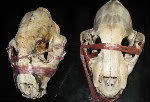|
|
Scientists have been counting tiger populations for decades, using a variety of methods including camera traps and DNA collected from tissue or blood after darting and sedating the world’s largest cat. However, a new method of surveying tiger populations could change scientists’ ability to non-invasively obtain accurate numbers for tiger populations around the world, according to a study in Biological Conservation.
The key is feces. Researchers with the Wildlife Conservation Society (WCS) and the National Centre for Biological Sciences, collected 58 tiger scats in India’s Bandipur Reserve in Karnataka, apart of the Western Ghats. Using material from the carefully collected feces, researchers were able identify individual tigers by DNA.
 Researchers collect tiger scat. Photo courtesy of WCS. |
To test the accuracy of their findings, they compared the results of DNA tests to counts made by camera traps in the reserve. Camera-trapping is considered the most accurate method of counting tigers; unfortunately, however, it is not practical in rugged terrain or areas where tiger density is low, such as Siberia.
“This study is a breakthrough in the science of counting tiger numbers, which is a key yardstick for measuring conservation success,” said noted tiger scientist Dr. Ullas Karanth of the Wildlife Conservation Society. “The technique will allow researchers to establish baseline numbers on tiger populations in places where they have never been able to accurately count them before. We see genetic sampling as a valuable additional tool for estimating tiger abundance in places like the Russian Far East, Sunderban mangrove swamps and dense rainforests of Southeast Asia where camera trapping might be impractical due to various environmental and logistical constraints.”
Tigers are classified as Endangered by the IUCN Red List, while the Sumatran Tiger and South China Tiger subspecies are considered Critically Endangered. Three subspecies have already gone extinct in the past century. Across their range, tigers suffer from habitat loss and poaching.
Citation: Samrat Mondol, K. Ullas Karanth, Samba Kumar, Arjun M. Gopalaswamy, Anish Andheria, Uma Ramakrishnan. Evaluation of non-invasive genetic sampling methods for estimating tiger population size. Conservation Biology(2009), doi:10.1016/j.biocon.2009.05.014.
Related articles
Rash of tiger attacks linked to deforestation by large paper corporation APP

(03/18/2009) The Sumatran tiger, a critically-endangered subspecies, is hanging on by a thread in its island home. Biologists estimate that at most 500 individuals remain with some estimates dropping as low as 250. Despite the animal’s vulnerability, large-scale deforestation continues in its habitat mostly under the auspices of one of the world’s largest paper companies, Asian Pulp and Paper (APP). Shrinking habitat and human encroachment has led to a rise in tragic tiger encounters, causing both human and feline mortalities.
Malaysia seeks to reverse collapse of tiger population due to poaching, logging, palm oil
(12/23/2008) A new law seeks to double Malaysia’s tiger population to 1,000 by 2020, reports BBC News.
Trafficking of tiger parts is rife in Myanmar
(10/15/2008) Trafficking of parts from endangered wild cats is rife in Myanmar (Burma) according to a new report from TRAFFIC, the wildlife trade monitoring network. Surveys conducted by TRAFFIC over the past 15 years have turned up 1,320 wild cat parts from at least 1,158 individual animals, including 107 tigers. The group says the toll in the country is far higher.